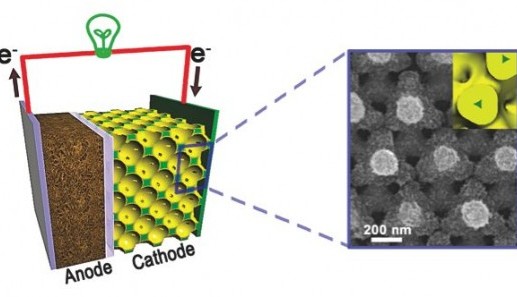Complete battery recharging within minutes
on

Of all the criticisms of electric vehicles, probably the most commonly-heard is that their batteries take too long to recharge -- after all, limited range wouldn't be such a big deal if the cars could be juiced up while out and about, in just a few minutes. Well, while no one is promising anything, new batteries developed at the
"This system that we have gives you capacitor-like power with battery-like energy," said U Illinois' Paul Braun, a professor of materials science and engineering. "Most capacitors store very little energy. They can release it very fast, but they can't hold much. Most batteries store a reasonably large amount of energy, but they can't provide or receive energy rapidly. This does both."
The speed at which conventional batteries are able to charge or discharge can be dramatically increased by changing the form of their active material into a thin film, but such films have typically lacked the volume to be able to store a significant amount of energy. In the case of Braun's batteries, however, that thin film has been formed into a three-dimensional structure, thus increasing its storage capacity.
Batteries equipped with the 3D film have been demonstrated to work normally in electrical devices, while being able to charge and discharge 10 to 100 times faster than their conventional counterparts.
To make the three-dimensional thin film, the researchers coated a surface with nanoscale spheres, which self-assembled into a lattice-like arrangement. The spaces between and around the spheres were then coated with metal, after which the spheres were melted or dissolved away, leaving the metal as a framework of empty pores. Electropolishing was then used to enlarge the pores and open up the framework, after which it was coated with a layer of the active material – both lithium-ion and nickel metal hydride batteries were created.
The system utilizes processes already used on a large scale, so it would reportedly be easy to scale up. It could also be used with any type of battery, not just Li-ion and NiMH.
The implications for electric vehicles are particularly exciting. "If you had the ability to charge rapidly, instead of taking hours to charge the vehicle you could potentially have vehicles that would charge in similar times as needed to refuel a car with gasoline," Braun said. "If you had five-minute charge capability, you would think of this the same way you do an internal combustion engine. You would just pull up to a charging station and fill up."
Braun and his team believe that the technology could be used not only for making electric cars more viable, but also for allowing phones or laptops to be able to recharge in seconds or minutes. It could also result in high-power lasers or defibrillators that don't need to warm up before or between pulses.
Source: Gizmag, Ben Coxworth


Discussion (0 comments)